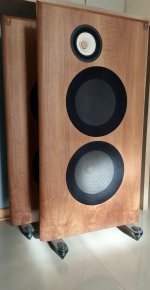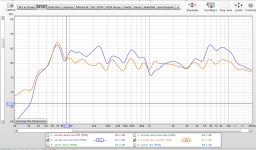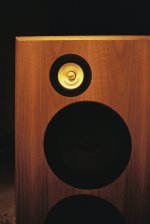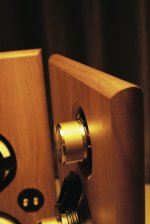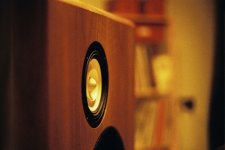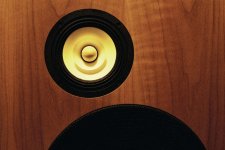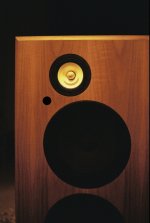Hi
I've completed recently my two way open baffle speakers (ones that everyone seems to do now), consisting of a single 4 inch wideband and two 12 inch woofers.
Crossed over at 300 Hz, with an active electronic crossover of 24 dB/Oct I've made.
Dsp is applied threw a convolution filter at a streamers end (volumio) and a final fr spans from around 40 Hz, to over 10 kHz, on axis at least (the orange FR is with dsp, the blue one without).
Although results are very good, I'm curious if adding a tweeter to the system would bring significant improvements.
Possible solution that I can think of:
1. Tweeter with a waveguide placed close to the wideband, crossed at around 3-4 kHz.
Waveguides are relatively wide and I can't really put the tweeter right next to the wideband. The lobing might be even more pronounced, as wideband-tweeter would be positioned horizontally.
Back wave of the speaker would be basically cut above 3 kHz.
2. Tweeter with a significantly higher crossover point (10kHz or so), pointing upwards. Never heard anything similar.
Any thoughts?
Cheers,
Stefan
I've completed recently my two way open baffle speakers (ones that everyone seems to do now), consisting of a single 4 inch wideband and two 12 inch woofers.
Crossed over at 300 Hz, with an active electronic crossover of 24 dB/Oct I've made.
Dsp is applied threw a convolution filter at a streamers end (volumio) and a final fr spans from around 40 Hz, to over 10 kHz, on axis at least (the orange FR is with dsp, the blue one without).
Although results are very good, I'm curious if adding a tweeter to the system would bring significant improvements.
Possible solution that I can think of:
1. Tweeter with a waveguide placed close to the wideband, crossed at around 3-4 kHz.
Waveguides are relatively wide and I can't really put the tweeter right next to the wideband. The lobing might be even more pronounced, as wideband-tweeter would be positioned horizontally.
Back wave of the speaker would be basically cut above 3 kHz.
2. Tweeter with a significantly higher crossover point (10kHz or so), pointing upwards. Never heard anything similar.
Any thoughts?
Cheers,
Stefan
Attachments
A tweeter that is small enough to sit above the midrange. I'm thinking of 2" bare units like the Vifa/Peerless ones, or Hi-vi. Also Sica makes a small 19 mm tweeter with a rectangular flange which has a a waveguide. For 16€ you don't expect top notch top end.Any thoughts?
La Voce makes two bare domes too (1" and 1.2" ) in that price range.
Dayton mini8 is too low SPL where you want to cross?! I believe I crossed it at about 10 kHz using 0.68μF and O.3 mH
On indirect tweeters, see
https://www.diyaudio.com/community/...ull-range-phase-coherency.403430/post-7457552
https://www.diyaudio.com/community/...ull-range-phase-coherency.403430/post-7457552
There's less than 5 cm above the driver, it wouldn't fit.A tweeter that is small enough to sit above the midrange.
Even if it would have, it would have a very wide directivity, compared to wideband at the crossover frequency.
Would a wool felt od 0.5-1cm thickness, glued around the tweeter, narrow the off axis dispersion?
Thanks, here's a few moreNice job on the baffle
Attachments
Beautiful build.
Maybe add a dipole ribbon tweeter above your baffle, on its own small baffle which is attached to the main baffle via a metal post or nice looking brackets?
Maybe add a dipole ribbon tweeter above your baffle, on its own small baffle which is attached to the main baffle via a metal post or nice looking brackets?
A small planar on top like @Plott’s speakers is a good idea. If those aesthetics don’t work, what about one of those press fit little tweeters snugged between the drivers? Or two of them, back to back, for dipole. Or one tacked onto the magnet of the full range. You could experiment with just taping them to the baffle first. Experimenting is key. Then decide to commit to any new holes or screws into those lovely baffles.
Attachments
That small tweeter looks really good in between drivers! I could angle the whole thing by adjusting spikes a bit to get the sound to the ear level.
Wouldn't a tweeter on top of the baffle cause some comb filtering and even more lobing?
Wouldn't a tweeter on top of the baffle cause some comb filtering and even more lobing?
No, as long as it is directed to the sides and beaming and cut below 5khz like described in my link with Tipps for implementation the tweeter should help the indirect sound field.
I needed some listening tests for adjusting the loudness and implementation.
Every room is different, so an L pad would help.
Astonishingly the side facing tweeters are allowed to play as loud as the main driver without disturbing the imaging. However they should beam.
Mr Pfleiderer used for this 5cm paper cone tweeters which were mounted from the backside of the wooden box. The 2cm thick wood helping to reduce dispersion of the side tweeters. Making it more beam.
I used for listening tests with Audax like car hifi tweeters some shortened paper tubes you can find in your bath.
Due to Haas effect:
https://en.m.wikipedia.org/wiki/Precedence_effect
I needed some listening tests for adjusting the loudness and implementation.
Every room is different, so an L pad would help.
Astonishingly the side facing tweeters are allowed to play as loud as the main driver without disturbing the imaging. However they should beam.
Mr Pfleiderer used for this 5cm paper cone tweeters which were mounted from the backside of the wooden box. The 2cm thick wood helping to reduce dispersion of the side tweeters. Making it more beam.
I used for listening tests with Audax like car hifi tweeters some shortened paper tubes you can find in your bath.
Due to Haas effect:
https://en.m.wikipedia.org/wiki/Precedence_effect
Ideally you would have the full range crossed to the tweeter. If you’re not going to change your existing active crossover, you could develop a simple passive two way at 7k or 10k. Then your full range amp would handle that. Or, use your DSP EQ to drop the highs from the full range driver and use a third amp with either passive line level crossover or passive speaker crossover for the tweeter. That’s getting more complicated.
Simplest thing is just to slap a tweeter (or two) wherever you want with a cap in series to protect it and see what it sounds like. Endless futzing!
Simplest thing is just to slap a tweeter (or two) wherever you want with a cap in series to protect it and see what it sounds like. Endless futzing!
Just to show you.
I got TV sound system 2.1 configuration.
Two 8cm fullrange and 20cm single subwoofer.
Indirect Audax type tweeters added having 2,2uF in line behind the TV facing up and so adding highs to the indirect sound field.

8cm fullrange, stereo.


A pair of indirect tweeters behind the TV facing up.
Important is that their sound arrives a bit later than the front wave. So I put them like this.
I got TV sound system 2.1 configuration.
Two 8cm fullrange and 20cm single subwoofer.
Indirect Audax type tweeters added having 2,2uF in line behind the TV facing up and so adding highs to the indirect sound field.
8cm fullrange, stereo.
A pair of indirect tweeters behind the TV facing up.
Important is that their sound arrives a bit later than the front wave. So I put them like this.
If you add tweeters with the full ranges on axis then you get problems in the time domain. With poor implementation always phasing problems destroying your fullrange Fast concept.
Just linearize your fullrange on axis with dsp and use side tweeters for the indirect sound field.
Just linearize your fullrange on axis with dsp and use side tweeters for the indirect sound field.
Ideally you would have the full range crossed to the tweeter. If you’re not going to change your existing active crossover, you could develop a simple passive two way at 7k or 10k. Then your full range amp would handle that. Or, use your DSP EQ to drop the highs from the full range driver and use a third amp with either passive line level crossover or passive speaker crossover for the tweeter. That’s getting more complicated.
Simplest thing is just to slap a tweeter (or two) wherever you want with a cap in series to protect it and see what it sounds like. Endless futzing!
I'll definitely try sticking the tweeter on the mid's magnet, or pointing it upwards first.
How about carving a horn through the baffle width (5cm/2inches) and mounting the tweeter on the rear surface of the baffle? That might align the tweeter with the mid and narrow the dispersion to the front.
The only issue might be a sub 3kHz rear wave, compared to full frequency on the front.
I would say there are only two good options. To emit sound vertically or backwards like a supetweeter above 10kHz. And you play with one capacitor and one resistor until you match it with FR. Sometimes a higher-order crossover is needed, sometimes a first-order one.
For example this is cheap, tried and tested, and sounds great.
https://www.ebay.ie/itm/256367403858
For example this is cheap, tried and tested, and sounds great.
https://www.ebay.ie/itm/256367403858
- Home
- Loudspeakers
- Multi-Way
- Tweeter add on consideration

